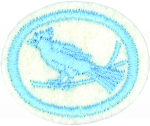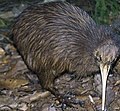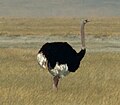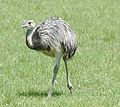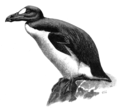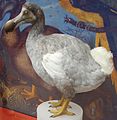Difference between revisions of "AY Honors/Birds/Answer Key/es"
(Created page with ":;Huesos huecos les permiten volar casi sin esfuerzo.") |
(Created page with ":;Un hueso de anillo en los ojos de los pájaros es lo que les permite enfocarse tan bien y tener una vista tan aguda.") |
||
| Line 50: | Line 50: | ||
:;Huesos huecos les permiten volar casi sin esfuerzo. | :;Huesos huecos les permiten volar casi sin esfuerzo. | ||
| − | :; | + | :;Un hueso de anillo en los ojos de los pájaros es lo que les permite enfocarse tan bien y tener una vista tan aguda. |
Revision as of 16:30, 17 February 2021
| Aves | ||
|---|---|---|
| Asociación General
|
Destreza: 1 Año de introducción: 1928 |
|
Requisitos
|
La especialidad de Aves es un componente de la Maestría Naturaleza. |
|
La especialidad de Aves es un componente de la Maestría Zoología. |
| Conexión Logros para la Investidura: Esta especialidad está relacionada con los requisitos de Logros para la Investidura para AMIGO Estudio de la naturaleza que requiere configurar una estación de alimentación e informar sobre las aves visitantes observadas durante un período de siete días como está escrito en el requisito 7a de esta especialidad. Esta especialidad es una elección popular para la especialidad de la categoría de Estudio de la naturaleza de nivel de destreza 1 requerido para los AMIGOS DE LA NATURALEZA. |
1
A menudo es útil comparar las características de grupos decriaturas para ver qué es lo mismo que otras criaturas, pero para identificarlas, es útil encontrar las diferencias también. Hay cinco clases de criaturas con una columna vertebral. Estas clases incluyen los peces, anfibios, reptiles, aves y mamíferos.
Todos los vertebrados tienen una columna vertebral, pero las aves tienen una serie de características únicas, tales como:
- Vuelan
- Huevos con cáscara dura
- Sangre caliente
- Cubiertos con plumas
- Huesos huecos
- Estructura ósea en el ojo
- Vista aguda
- Voces musicales
- Capacidad para detectar campos magnéticos
- Muy coloridos
Cada una de estas cosas parece bastante única, pero cuando miramos las otras clases de vertebrados, encontramos que las aves no son las únicas criaturas que pueden volar. Hay peces voladores, serpientes que planean, ranas que planean y murciélagos. Cada clase de vertebrados tiene la capacidad de volar y los murciélagos al menos pueden igualar la capacidad de vuelo de las aves. También debemos observar que no todas las aves son capaces de volar (pingüinos, avestruces y otros son incapaces de volar).
Los mamíferos son de sangre caliente entonces eso no es exclusivo de las aves. Las ballenas, las ranas y algunos de los primates tienen voces muy musicales, aunque pocos se pueden comparar con las aves liras de Nueva Guinea o incluso con un simple cenzontle. Muchos de los mamíferos como los suricatos tienen buena vista, entonces tampoco es único, y la mayoría de los peces tienen la capacidad de detectar campos electromagnéticos.
Cuando hemos comparado las distintas clases, encontramos que hay sólo algunas cosas que son exclusivas de la clase Aves.
- Todos ponen huevos de caparazón duro que ellos incuban usando su temperatura corporal.
- Todos ellos están cubiertos con una estructura de plumas que difiere mucho de las escamas y la piel.
- Huesos huecos les permiten volar casi sin esfuerzo.
- Un hueso de anillo en los ojos de los pájaros es lo que les permite enfocarse tan bien y tener una vista tan aguda.
All of these characteristics give us an idea of what makes birds unique and also an idea as to why we are so drawn to these colorful, flying creatures.
2
The Alca impennis (Great Auk) and the Raphus cucullatus (Mauritius Dodo) are pictured with the other flightless birds because they were flightless birds that faced many of the same dangers of some of the current flightless birds such as the Apteryx (kiwis). Man and animals that come with man such as dogs, pigs, cats, and rats are very dangerous for any birds that nest on the ground. Many flightless birds have become extinct because of man and his actions. These two species represent a far larger number that have become extinct at the hand of man.
Cassowary
- Cassowaries are native to the tropical forests of New Guinea and northeastern Australia. Some nearby islands also have small cassowary populations, but it is not known if these are natural or the result of the New Guinea trade in young birds. They are frugivorous; fallen fruit and fruit on low branches are the mainstay of their diet. They also eat fungi, snails, insects, frogs, snakes and other small animals.
Emu
- The Emu is the largest bird native to Australia. They eat a variety of plant species; the type of plants eaten depends on seasonal availability. They also eat insects, including grasshoppers and crickets, lady beetles, soldier and salt bush caterpillars, cotton-boll moth larvae and ants.
Kiwi
- Kiwis are from New Zealand. They eat small invertebrates, seeds, grubs, and many varieties of worms. They also may eat fruit, small crayfish, eels, and amphibians. Their long beaks, with nostrils at the end of them, help them to catch prey.
Ostrich
- Ostriches live in the savannas of Africa. They mainly feed on seeds and other plant matter; occasionally they also eat insects such as locusts. Lacking teeth, they swallow pebbles that help as gastroliths to grind the swallowed foodstuff in the gizzard. An adult ostrich typically carries about 1 kg of stones in its stomach.
Penguin
- Penguins are aquatic birds living exclusively in the Southern Hemisphere. Most penguins feed on krill, fish, squid, and other forms of sea life caught while swimming underwater. They spend half of their life on land and half in the oceans.
Rhea
- Rheas are native to South America. They are omnivorous, preferring broad-leafed plants, but also eating seeds, roots, fruit, insects, and small vertebrates.
3
Birds were created on the Fifth day - see Genesis 1:20-23
Pelican, Raven, Owl - Isaiah 34:11
Chicken or Cock- Matthew 23:37, Luke 13:34
Eagle - Jeremiah 49:22, Jeremiah 4:13, Job 9:26, Deuteronomy 28:49, Job 39:27-29
Ostrich (NKJV) or Owl (NIV) - Micah 1:8
Dove - Genesis 8:8-11, Matthew 10:16, Hosea 7:11
Eagle, Buzzard, Kite, Falcon, Raven, Ostrich, Owl, Sea Gull, Hawk, Little Owl, Cormorant, Great Owl, White Owl, Pelican, Vulture, Stork, Heron, and Hoopoe- Leviticus 11:13-19
Peacock - 1 Kings 10:22
Raven - 1 Kings 17
Partridge - Jeremiah 17:11
Various Bible versions may translate the original Scriptures differently e.g. one version may use "kite," while another may use "falcon." The texts given are examples, and some birds are named many times.
4
"Children should be encouraged to search out in nature the objects that illustrate Bible teachings, and to trace in the Bible the similitudes drawn from nature. They should search out, both in nature and in Holy Writ, every object representing Christ, and those also that He employed in illustrating truth. Thus may they learn to see Him in tree and vine, in lily and rose, in sun and star. They may learn to hear His voice in the song of birds, in the sighing of the trees, in the rolling thunder, and in the music of the sea. And every object in nature will repeat to them His precious lessons." Child Guidance, p. 46.
1. God created the birds to point to Himself as the provider of all that we need. If He takes care of the birds, He shall surely take care of our needs. (Luke 12:24)
2. Birds teach us about God. (Job 12:7-9)
- God says he will protect us like the mother hen protects her chicks. (Matt. 23:37)
- Jesus said God sees the sparrow fall, and much more He sees us. (Matt. 10:29-31)
- He will give us strength like that of the eagle. (Isa. 40:31)
3. The adaptations of birds (especially their beaks, their legs and feet) show us God's creative power.
4. We ought to trust God totally just as birds do. (Matt 6:26)
5. Jesus loves everybody and every thing and as He takes the animals in to account before He does something, He wants us to do so as well. (Jonah 4:11)
5
Birders equip themselves with a good field guide and a checklist of birds found in the the local area they are birding. While the field guide may cover the whole continent or country and include helpful pictures and data that help you fill in the info you need for this requirement, a local checklist will narrow down the birds you can expect to actually see.
You can easily find bird checklists online - look for a birding club in your area or check out /http://avibase.bsc-eoc.org/avibase.jsp?lang=EN which is based in Canada but covers the world with various degrees of completeness.
You can also consult Wikibooks' Guide to Birds to help you identify some birds. As of this writing, this field guide is still in its infancy, so you might be well served to purchase a more thorough field guide book, especially since physical field guides don't need batteries or wi fi. Field guides are generally tailored to a specific area of the world, so be sure to consult one that covers your area.
The Birds - Advanced honor requires observing 30 additional birds and collecting additional information, so if you want to earn the advanced honor you should follow the additional requirements for the first 30 birds right from the start. The requirement says:
10. Make a list of 60 species of wild birds, including birds from at least ten different families, that you personally have observed and positively identified by sight out of doors. For each species on this list note the following: a. Name b. Date observed c. Place observed d. Habitat (i.e., field, woods, river, lake, etc.) e. Status where observed (permanent resident, winter resident, summer resident, migrant, vagrant)
6
The Guide to Birds has "bird call" links for several birds (though it is not yet exhaustive). Listen to the most common birds in your area so that you may learn to identify them by their calls. Many birds (such as the woodpeckers and the Bobwhite) are a lot easier to identify by their calls, because they are so much easier to hear than to see.
You can also purchase CD's from Peterson's Birding by Ear series. Select one that was made for your region.
7
7a
This should be done by the individual
7b
7c
i
Hummingbird nectar should consist of four parts water to one part sugar (by volume).
ii
Honey promotes the growth of a fungus that can kill hummingbirds&, so it should never be used.
The assertion that food coloring is bad for hummingbirds has been around since the 1970's, but it has never been proven conclusively&. However, since there is no reason to put food coloring in the nectar, why bother? The hummingbirds can find the feeder by the feeder's color, so it is not necessary to color the nectar.
iii
The feeder should be cleaned weekly.
iv
Every time you clean the feeder, check for black mold. If you find any, clean the feeder with bleach. Do not clean a feeder with soap (but you can use white vinegar as long as you rinse it thoroughly afterwards). If hummingbirds are not emptying the feeder before the syrup spoils, don't fill it completely next time. Spoiled syrup will appear cloudy and must be discarded - hummers won't eat it.
Clean the feeder thoroughly once per month with a bottle brush. Soak it in a solution of a 60ml![]() bleach and 4 liters
bleach and 4 liters![]() of water. Rinse well, and refill with syrup.
of water. Rinse well, and refill with syrup.
Unless precautions are taken, ants will get into your feeder. Look for a dripless feeder with an ant moat. These are very effective at addressing the problem.
7d
Different habitats may include:
- Fresh water (rivers, lakes, ponds, etc.)
- Salt water (bays & ocean)
- Fields & meadows
- Forests
- Desserts
- Wetlands
Choose three such areas and observe them. Make lists of the birds you see in each area. You should expect to see differences, as different birds frequent different habitats. For example, you should expect to see herons, pipers, ducks and geese near water, and you should expect to see meadowlarks in fields, and so forth.
References
- Categoría: Tiene imagen de insignia
- Adventist Youth Honors Answer Book/Honors/es
- Adventist Youth Honors Answer Book/es
- Adventist Youth Honors Answer Book/Skill Level 1/es
- Categoría: Libro de respuestas de especialidades JA/Especialidades introducidas en 1928
- Adventist Youth Honors Answer Book/General Conference/es
- Adventist Youth Honors Answer Book/Nature/es
- Adventist Youth Honors Answer Book/Stage 100/es
- Adventist Youth Honors Answer Book/Naturalist Master Award/Fauna/es
- Adventist Youth Honors Answer Book/Zoology Master Award/Fauna/es
- Adventist Youth Honors Answer Book/IAConnection/es
- Adventist Youth Honors Answer Book
- Adventist Youth Honors Answer Book/Do at home
